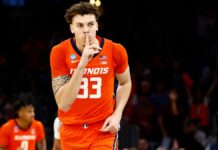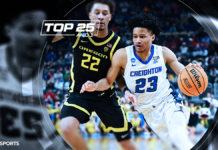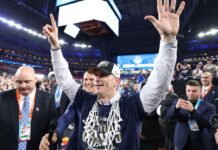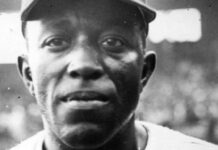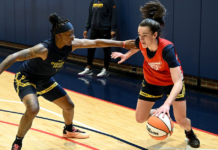WNBA training camp for the 2023 season begins on Sunday, and, as usual, teams don’t have much time to make important roster decisions before the games officially begin on Friday, May 19. While WNBA teams can typically have up to 15 players in camp at any one time, some players will be arriving to camp late due to overseas commitments, which complicates matters.
That being said, there are plenty of players whose roster spots for the 2023 season are more or less secured, and a flurry of activity during the past offseason’s free agency period leaves some of these players in positions to have career years. Here are 10 players who could make the 2023 WNBA season their most productive.
Aari McDonald (Atlanta Dream)
By a point guard’s third season in the WNBA, they’re generally expected to have adjusted to the speed of the professional game and to have picked up the nuances that are required for success at the position. McDonald will have a golden opportunity in 2023 to prove she’s the Dream’s long-term answer at point guard; save for the soon-to-be 34-year-old Danielle Robinson, Atlanta has few other ball handlers on its roster, and the Dream’s emphasis on wing players in the 2023 WNBA Draft suggests that they’re comfortable rolling with McDonald in the starting lineup. Last season, McDonald played well when multiple Dream injuries forced her into a starting role, averaging 16 points (60 percent true shooting percentage) and 4.7 assists (2.00 assist/turnover ratio) per game, so hopefully that’s a sign of things to come for the dynamic young guard.
Alanna Smith (Chicago Sky)
No team lost more in free agency than the Sky, who opted to reload by acquiring several veteran players rather than rebuild. It’s easy to see that most of these players — Marina Mabrey, Isabelle Harrison and Elizabeth Williams, in particular — will factor heavily into the Sky’s rotation this season, but don’t sleep on Smith’s potential impact, either. According to The Next, Chicago outbid other teams by offering Smith a guaranteed salary, and after the team suspended Astou Ndour-Fall’s contract for the season, there aren’t any other frontcourt players on its roster who can reliably shoot the ball from 3-point range. Smith has struggled to hold onto a consistent offensive role thus far in her WNBA career, but most signs point towards that changing in Chicago.
Ezi Magbegor (Seattle Storm)
Magbegor was well on her way to Defensive Player of the Year consideration in 2022 before Seattle’s midseason acquisition of Tina Charles pushed her to the bench. Prior to that, Magbegor was averaging 11.3 points, 6.5 rebounds and a league-leading 2.3 blocks per game in 28.3 minutes played. With the Storm now firmly in rebuilding mode, the 23-year old center will have the opportunity to both get back to that level of production and sustain it for an entire season.
Tyasha Harris (Connecticut Sun)
Harris had a decent, if low-usage, rookie season for the Wings in 2020, but over the next two years, inconsistent minutes and a near-constant position battle between her and other point guards on the team made it clear that Harris’ role in Dallas would grow no larger. She’ll get a fresh start in Connecticut after being traded there in the offseason, and while Harris will probably still be coming off the bench for the Sun, there’s a better chance she has the ball in her hands when she does see the court. Harris’ steadiness with the basketball (2.8 career assist/turnover ratio) will make her a good complement to the playmakers on Connecticut’s roster.
NaLyssa Smith (Indiana Fever)
The Fever once again finished with the WNBA’s worst record in 2022, but Smith showed glimpses of stardom as their first-round draft pick, ranking second among rookies in scoring (13.5 points per game) and first in rebounding (7.9 rebounds per game). How Smith fits next to the Fever’s 2023 first-round pick, Aliyah Boston, remains to be seen, but she’s going to be a franchise cornerstone regardless, so expect her to continue to get plenty of reps in 2023 as Indiana builds.
Jewell Loyd (Seattle Storm)
It almost feels wrong to include a four-time All-Star and two-time All-WNBA honoree on a list like this, but with the Breanna Stewart and Sue Bird eras officially over in Seattle, the Storm are now decidedly Loyd’s team. The Storm have never been shy about letting Loyd shoot the ball (career 25.8 percent usage rate), and without a clear-cut secondary scoring option on the roster, her light will be neon-green. The only question will be how the rebuilding Storm handle Loyd’s minutes later in the season; her contract will be up heading into 2024, and you can bet the franchise will do whatever it takes to keep her in Seattle.
Dana Evans (Chicago Sky)
Evans’ playing time was sparse during her first two seasons in Chicago, but that’s likely to change in 2023. With longtime Sky point guard Courtney Vandersloot now in New York and Julie Allemand taking the WNBA season off, Evans is the team’s only returning ballhandler, and Sky head coach James Wade says he’s ready to give her a larger role. Evans’ primary appeal is as a shooter, but even if she continues to come off the bench for the Sky, it’s plausible that Wade staggers his rotations in a way to use her as a primary ballhandler alongside the newly-acquired Marina Mabrey.
Azurá Stevens (Los Angeles Sparks)
Stevens got a hefty contract from the Sparks this past offseason, so it goes without saying that they have big plans for her. The 6-foot-6 forward’s versatility on both ends of the court made her a vital part of Chicago’s success in recent years, yet it was often as the team’s third big, particularly when she was playing behind Candace Parker and Emma Meesseman. Stevens figures to have a larger role than that in her first season in Los Angeles, and if new Sparks head coach Curt Miller can find her more minutes than the low-20s she was playing in Chicago, she’ll stuff the stat sheet with points, 3-pointers and blocked shots.
Shakira Austin (Washington Mystics)
Austin was as good as advertised in her rookie season for the Mystics, and while she played only 21.6 minutes per game as the team’s starting center, her rebounding (6.5 per game), soft touch around the rim and general efficiency with the basketball made her a productive player nonetheless. Now that Austin has hurdled the rookie wall, expect first-year Mystics head coach Eric Thibault to be more generous with her court time, and Austin to respond with increased scoring, rebounding and shot-blocking.
Brionna Jones (Connecticut Sun)
How much better can Jones get? The 2021 Most Improved Player and 2022 Sixth Woman of the Year will be returning to Connecticut’s starting lineup this season after the team traded Jonquel Jones to New York, and she figures to have a more prominent offensive role as the team’s new go-to post player. With a career true shooting percentage north of 60 percent, Jones’ scoring efficiency has never been in question, and if the Sun make a concerted effort to get her the ball more often in 2023, she’ll at least match her most productive season (2021; 14.7 points and 7.3 rebounds per game), if not eclipse it.






















